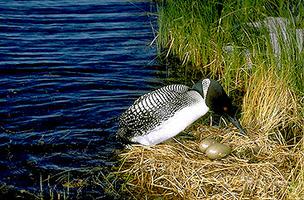Bird Distribution and Habitat
Animals' lives are circumscribed by 2 imperatives: finding food for survival, growth and reproduction and avoiding becoming prey before reproducing. For an animal to occupy a habitat, it must be able to survive and reproduce within it. Birds have evolved many ways of meeting these challenges. Their feeding structures (feet, bills, gastrointestinal tracts) are adapted to take available foods. Plumage structure, colour and pattern protect them from their physical environment and camouflage them from potential predators and sometimes from potential prey.
Habitat
Their behaviour patterns use these physiological adaptations to meet the 2 imperatives and, at the same time, enable each species to recognize its own kind. For example, the birds of Canada's south-central plains are adapted for the zone's short, sparse vegetation. Their feet are adapted for walking (not hopping). Food, mainly plant parts or invertebrates, is taken with bills adapted to clip vegetation, crush seeds or pick up invertebrates. Many species forage in flocks, thereby enhancing their efficiency in finding food and perhaps increasing their relative safety.
Plumage, characteristically dull-coloured, often with darker streaks and vermiculations (wavy lines), allows them to blend with their habitat; contrasting colours, usually confined to underparts or flight feathers, become apparent only when the bird is in flight. Most species (eg, long-billed curlews, horned larks and chestnut-collared longspurs) advertise their occupancy of space to prospective mates and competing members of the same species through aerial displays that are unique for each species. These displays, which are accompanied by song or other vocalizations, make use of special flight patterns that show off contrasting colours.
Distribution
The power of flight has enabled birds to overcome barriers to dispersal (eg, deserts, mountains, oceans) and to establish themselves in the breeding fauna of continents and islands throughout the world. Often, they have apparently been aided in colonizing new habitats by accidents - for example, being blown off course by storms during migration or, more recently, by human activities (transport of species into areas where they did not exist previously, as with the house sparrow).
Distribution of any given species is limited by availability of appropriate habitat. The number of species of breeding birds, greatest in the tropics where habitats have had most time to diversify, diminishes towards the poles, mountain tops and islands farthest from continental shores. For example, 1556 species of birds have been recorded breeding in the tropical forests of Colombia (5° north latitude), whereas on Ellesmere Island (82° north latitude) breeding species fall to fewer than 20.
The distribution of birds is constantly changing: some species expand their range; others exhibit an ever-contracting distribution; still others fluctuate, expanding for a while, then declining again. Two major factors influence such changes: human activities and prolonged shifts in climate. Both influence availability of food and protective cover that enable birds to survive and reproduce.
Canada's Avifauna
The avifauna of Canada now consists largely of species that are believed to have evolved elsewhere and to have subsequently invaded habitats available in northern North America. Wood warblers, blackbirds and flycatchers are among families that apparently evolved in tropical America and spread north, via the Isthmus of Panama and Caribbean Islands, to inhabit various habitats across Canada each spring and summer. By contrast many other families (e.g. grouse, thrushes and finches) are believed to have originated in Eurasia and then invaded North America via Beringia. Many species in these families reside or winter in the more southern parts of Canada.
See also Migration; and individual entries on birds.

 Share on Facebook
Share on Facebook Share on X
Share on X Share by Email
Share by Email Share on Google Classroom
Share on Google Classroom










